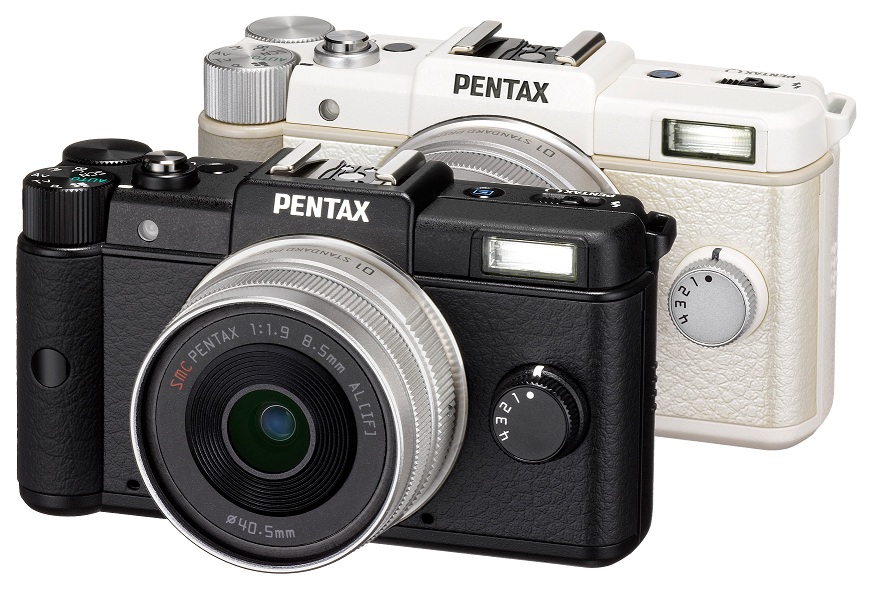Pentax Q: Smallest compact interchangeable lens camera sports biggest price tag

Last week, Pentax jumped into the compact interchangeable lens camera fray with the announcement of the Pentax Q. Roughly the size of a Canon PowerShot S95 (without a retractable lens) and not much heavier, it's currently the smallest mirrorless interchangeable lens camera on the market, though it sports the biggest price tag at $800 (with a 47mm equivalent f/1.9 standard prime kit lens). It seems you'll be paying the premium for the diminutive size and retro-cool styling, rather than top-notch image quality, though.
The biggest sacrifice Pentax made to shrink the size of the camera was to use a tiny 1/2.3-inch image sensor (smaller sensor = poorer image quality). To get an idea of how small that is, check out this sensor-size comparison and note that competing interchangeable lens cameras from Olympus and Panasonic use the Four Thirds System size sensors (in red) while those from Sony use even larger APS-C size sensors (in greenish yellow). The Q's little 1/2.3-inch sensor would fall somewhere between the 1/2.5 and 1/1.8 inch sensors, which are typically found in compact point-and-shoots rather than higher-end cameras. In fact, the Q's sensor is even smaller than the $400 Canon S95's, though to mitigate the issue, Pentax chose to use a backside illuminated CMOS sensor which should improve performance in low-light. Still, the Q's 12.4 megapixel sensor seems better suited for a compact point and shoot and is likely comparable to the similar sensor in the Nikon Coolpix P300, a high-end point-and-shoot which, like the S95, is priced significantly lower than the Pentax Q ($330).
With all that in mind, I really can't figure out what Pentax was thinking setting the Q's price at $800. With image quality poised to compete with the high-end compact set (which aren't slouches, but can't compete with their bigger-sensor brethren), pricing the camera higher than the rest of the interchangeable lens compacts doesn't make sense to me. Even the recently announced Panasonic Lumix DMC-GF3 with its much larger sensor will sell for $100 less (at $700 bundled with a 28mm equivalent f/2.5 lens), and the Sony Alpha NEX-C3, which boasts a APS-C-sized backside illuminated CMOS sensor sells for just $600 (bundled with a 24mm equivalent f/2.8 lens).
So what does the price premium buy you? It's certainly small (though I personally prefer a little more heft on interchangeable lens cameras, especially when shooting with longer zoom lenses). It shoots 1080p HD video at 30 fps (as does the Panasonic GF3, but not the Sony NEX-C3). A well extended pop-up flash gets the light further from the lens than most similar units. And I do like the look of the camera a lot. Pentax has arguably done one better than Olympus at recreating the nostalgic retro rangefinder camera look. The cool Quick Dial on the front (labeled with a simple 1, 2, 3, and 4) looks so ... analog. (The Quick Dial is even useful: you can assign it to access the various creative modes, special effects, or other camera settings, so you don't have to wade through a menu system to get to your favorite settings.) But if you're into paying a premium for retro, the Fujifilm X100 is even cooler looking and the $1,200 price tag will buy you better image quality with its SLR-sized sensor and a hybrid optical/electronic viewfinder to boot (the Q's optional shoe-mounted viewfinder will set you back another $250, though the Panasonic GF3 and Sony NEX-C3 don't even offer one).
Ah, but the Pentax Q gives you interchangeable lenses you say. Well, sure, but two of the four jointly announced lenses are cheap "toy" lenses (the 35mm equivalent Pentax 04 Toy Lens Wide and the 100mm equivalent Pentax 05 Toy Lens Telephoto, which will sell for $80 each) and the $130 Pentax 03 Fish-Eye lens might as well be a toy. There is also a 27.5-83.0mm equivalent, f/2.8-4.5 standard zoom lens that will set you back a whopping $300. And that's it as far as lenses go, since there's currently no adapter available to allow the use of any other lenses.
In the end, I think Pentax does have a target market pegged: Folks who want to look cool, shoot fun images (quality be damned) and for whom price isn't so much of an issue.
Related stories on ZDNet:
- ZDNet Photo Gallery: Panasonic Lumix DMC-GF3 photos
- Panasonic's new Lumix DMC-GF3 interchangeable lens camera is compact and curvy
- Olympus announces new PEN E-PL2 Micro Four Thirds interchangeable lens camera
- CES: New Olympus XZ-1 challenges Canon S95 for high-end compact camera crown
- Fujifilm announces March ship date for FinePix X100 high-end compact camera
Other related links:
